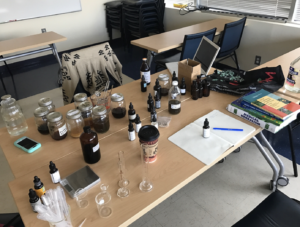Accessibility, as well as sustainability for me are central concepts in the modality of Western Herbalism. What follows are some herbs and dosage regimens that would cost under 5 dollars a momnth. These herbs all have a therapeutic benefit for frequently encountered imbalances.
MRH = Mountainroseherbs.com
- Ashwagandah – 453g (MRH) Daily 1g dose .033 a gram or 96 cents a month
- Celery Seed – 453g for 8.00 (MRH) Daily 2g dose 0.035 a dose, or 96 cents a month
- Cacao powder – 1359g for 17.00 (Amazon) Daily 1.5g Dose 0.0125 a dose or 56 cents a month
- Cinnamon – 453g for 11.68 (Amazon) Daily 1g Dose 0.02 a dose77 cents a month
- Gymnema sylvestre 453g for 9.00 (MRH) Daily 3g Dose 0.05 a dose $1.78 a month
Total herb Cost: 5.03
Ashwagandah is hypocholesteroemic, lowers cortisol, and has been traditionally used as what we now would consider an adaptogen. Stressed, underserved populations would benefit from a low cost adaptogen. Dosage varies wildly by source. 1g is probably a minimum therapeutic dose.
Celery seed is has been shown to have anti-inflammatory properties and is useful in the treatment of rheumatism and arthritis. Dosage starts at 0.5g TID by decoction or capsule (Bone, 2003) and (Braun & Cohen, 2015).
Theobroma cacao is a powerful antioxidant with hyoplipidemic and hypotensive properties (Braun & Cohen, 2015). The dosage advice varies widely 1.5g is a low therapeutic dose.
Cinnamonium verum enhances insulin sensitivity, and has demonstrated hypoglycemic and anti atherosclerotic activity (Braun & Cohen, 2015.) Dosage ranges from 1 to 4g.
Gymnema exhibits a broad range of therapeutic effects as an effective natural remedy for diabetes, besides being used for arthritis, diuretic, anemia, osteoporosis, hypercholesterolemia, cardiopathy, asthma, constipation, microbial infections, indigestion, and anti-inflammatory (Tiwari, Mishra, & Sangwan, 2014)
Ashwaganda, cinnamon and cocoa can be mixed with oats into a ball with peanut butter or rolled oats and packed for work or mixed into cereal or yogurt in the morning. All of these powders with the exception of cinnamon because of it’s strong taste can be mixed into pretty much everything without too much trouble. Cinnamon can be incorporated into dishes that benefit from it as a spice. The Gymnema and the Celery could be taken as a water extraction and flavored with the cinnamon. In addition to incorporating these as foods they could be taken directly as powders of put into capsules although with all the delicious ways of using these herbs in foods, capsuling them seems like a waste of time.
References:
Bone, K. (2003). A clinical guide to blending liquid herbs: herbal formulations for the individual patient. St. Louis, Mo: Churchill Livingstone.
Braun, L., & Cohen, M. (2015). Herbs and natural supplements an evidence-based guide. (4th ed., Vol. 2). Edinburgh: Churchill Livingstone.
Tiwari, P., Mishra, B. N., & Sangwan, N. S. (2014). Phytochemical and Pharmacological Properties of Gymnema sylvestre: An Important Medicinal Plant. BioMed Research International, 2014. https://doi.org/10.1155/2014/830285
